2004 Jeonju International Film Festival Report
by Tom Giammarco and Davide Cazzaro

Silence Between Two Thoughts (Iran), dir. Babak Payami
* Featured below are two perspectives of the Jeonju International Film Festival, from Tom Giammarco and Davide Cazzaro. Tom lives just outside Jeonju and teaches English at Woosuk University. He also recently began a Ph.D. program at Woosuk focusing on Korean cinema. Davide lives in Venice, and is currently writing a dissertation on New Korean Cinema for the Universita Ca' Foscari in Venice. In recent years he has attended the Pusan, Puchon, and Jeonju festivals as a special guest.
Davide Cazzaro
Jeonju is located in North Jeolla province, about 250 km from Seoul. Well-known for its delicious food and splendid landscapes, this city of the traditional arts, as it's usually called, is the right place for those who want to escape from the stress of the capital.
The local government has invested a lot in the cultural sector and not many are aware of the fact that this city is also an important place for the Korean film industry. In the ratio between the number of citizens and admissions, every year Jeonju is the place where Korean movies sell the highest number of tickets nationwide. The city is also popular as a filming location for movies. All of these characteristics make the city the perfect place to host a film festival of great proportions.
The Jeonju International Film Festival was founded in the year 2000 and since its first edition has tried to establish itself as an important event both nationally and internationally.
Even if it still lacks the stability that has propelled the Pusan International Film Festival (PIFF) -- in its five years there was a change of directors and programmers on which depends the durability and organization of the festival itself -- the Jeonju International Film Festival is gradually earning its own important spot on the international scene.
Following PIFF and PiFan (Puchon International Fantastic Film Festival), JIFF is the third most prestigious film festival in South Korea. In general we'd say that PIFF provides annually a wide window open on the Middle East and East Asian cinema, PiFan screens fantasy films from all over the world, and JIFF has found its own raison d'etre with independent and digital films of different countries, as well as different formats and years of production.
It's beyond dispute that there are far too many film festivals in the world but JIFF, like the other two main Korean film festivals, succeeded in achieving a symbiotic relationship with the domestic film culture.
Thanks also to the ongoing success of Korean cinema, the festival has become a great opportunity for debut or established filmmakers to present their indie and low-budget productions. This gives the audience a chance to see some rare and unique films with many different artistic and cultural backgrounds all following the slogan of freedom, independence and communication coined last year by the new festival director Min Byung-lock.
The strength of the festival is the great variety of programs offered to the public. These go beyond a great selection of movies and includes masterclasses, meetings with the directors, conferences, workshops and art exhibitions.
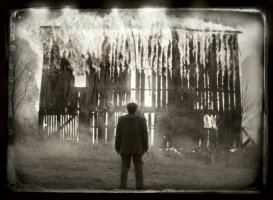 The ten days of the fifth edition took place from the end of April to the beginning of May, in blooming spring, and more than 280 works (short, medium and feature films) coming from 33 countries were brought in. The festival consisted of two main competition parts, Indie Vision and Digital Spectrum and fifteen other noncompetitive sections. Indie Vision represented one of the main new-entries among the sections as it went under the name Asian Independent Film Forum in last year's edition and it used to include exclusively Asian productions. The will to offer an ever increasing variety of contents, together with the difficulty of getting international premieres of Asian films, convinced the programmers to open the section as much as possible: among the sixteen movies in competition the most relevant were, War (pictured right) by Jake Mahaffy from USA, a feature film shot on 35 mm; the documentary I Want to Be a Documentarian by Korean female director Lee Eun-a, shot in DV format; and the third feature by famous Iranian director Babak Payami, Silence Between Two Thoughts, winner of the section's award. The other section, Digital Spectrum has remained unchanged since the first edition and this year it presented fourteen projects shot on the three main digital formats: Digibeta, Beta SP and DV. Every year the Digital Spectrum section represents one of the best selections of international projects that, using a format that is no longer new, experiments and challenges the positive and negative aspects of digital devices.
The ten days of the fifth edition took place from the end of April to the beginning of May, in blooming spring, and more than 280 works (short, medium and feature films) coming from 33 countries were brought in. The festival consisted of two main competition parts, Indie Vision and Digital Spectrum and fifteen other noncompetitive sections. Indie Vision represented one of the main new-entries among the sections as it went under the name Asian Independent Film Forum in last year's edition and it used to include exclusively Asian productions. The will to offer an ever increasing variety of contents, together with the difficulty of getting international premieres of Asian films, convinced the programmers to open the section as much as possible: among the sixteen movies in competition the most relevant were, War (pictured right) by Jake Mahaffy from USA, a feature film shot on 35 mm; the documentary I Want to Be a Documentarian by Korean female director Lee Eun-a, shot in DV format; and the third feature by famous Iranian director Babak Payami, Silence Between Two Thoughts, winner of the section's award. The other section, Digital Spectrum has remained unchanged since the first edition and this year it presented fourteen projects shot on the three main digital formats: Digibeta, Beta SP and DV. Every year the Digital Spectrum section represents one of the best selections of international projects that, using a format that is no longer new, experiments and challenges the positive and negative aspects of digital devices.
Among the other sections it is worth noting the Filmmakers Forum, introduced last year with the purpose of studying the aesthetical and practical elements composing films. The 2004 Forum was dedicated to three world class cinematographers: Caroline Champetier from France (one of the most famous female cinematographers in the world), Jung Il-sung from South Korea (but born in Tokyo) and Walter Carvalho from Brazil.
That was an opportunity few fellow cinematographers and film students would miss: four whole days to study, understand and debate the technical choices of cinematographers with very different roots and professional backgrounds.
In addition to the seminar the festival offered a small selection of movies where the role of each cinematographer was particularly relevant. The part dedicated to Jung Il-sung offered to those who study Korean cinema the rare chance to see on the big screen some masterpieces of the past: Son of Man (Yu Hyun-mok, 1980), Mandala (1981) and Chunhyang (2000) by Im Kwon-taek and especially the hard to find Hwang Jin-i (Bae Chang-ho, 1986).
Almost as a confirmation of the intent to stimulate and reinterpret the dialectic between tradition and modernity that characterizes Korean society, culture and cinema of the last years, JIFF Jeonju Sonimage (appearing from last year's edition) offered to the public a unique experience: three silent films from the twenties: Diary of a Lost Girl (1929, by German director Georg Wilhelm Pabst), The Smiling Madame Beudet (1929) and The Seashell and the Clergyman by avant-garde French director Germain Dulac accompanied by an ensemble composed by Park Chang-soo (South Korea, piano), Kevin Norton (USA, percussions), Chino Svuichi (Japan, computer music) and Alfred Harth (Germany, clarinet and saxophone) performing a live jam session, where modern jazz blends with contemporary music, in a extraordinary bridge between images of almost a century ago and sounds of the present.
 Another interesting section is Digital Short Films by Three Filmmakers, in which since the first edition of JIFF three Asian filmmakers are invited to realize a short film each (of about 30 min.), using digital devices. The festival fully finances the project and leaves total freedom to the directors. The past editions of JIFF have seen among others Zhang Yuan and Jia Zhang Ke (China), Park Kwang-su (South Korea) and Tsai Ming-liang (Taiwan), and in the 2004 edition were Bong Joon-ho (South Korea) with Influenza, Ishii Sogo (Japan) with Mirrored Mind and Yu Lik Wai (Hong Kong) with his Dance With Me to the End of Love. A remarkable piece, Influenza confirms Bong's talent also in the short films (a talent already demonstrated with Incoherence, Bong's graduation short project), and runs on the feeble line that divides reality from fiction, in a peculiar false documentary based on a man's violent deeds. The entire story is filmed with digital cameras, positioned as regular security cameras we find everywhere in Seoul. And the "coldness" of digital technology is amplified by the inscrutable eye of the security cameras, completely indifferent to the violence shown on the scene, and gradually increasing during the film. With Influenza Bong suggests that the very same indifference is slowly contaminating every corner of the Korean society, as a sneaky and dangerous disease.
Another interesting section is Digital Short Films by Three Filmmakers, in which since the first edition of JIFF three Asian filmmakers are invited to realize a short film each (of about 30 min.), using digital devices. The festival fully finances the project and leaves total freedom to the directors. The past editions of JIFF have seen among others Zhang Yuan and Jia Zhang Ke (China), Park Kwang-su (South Korea) and Tsai Ming-liang (Taiwan), and in the 2004 edition were Bong Joon-ho (South Korea) with Influenza, Ishii Sogo (Japan) with Mirrored Mind and Yu Lik Wai (Hong Kong) with his Dance With Me to the End of Love. A remarkable piece, Influenza confirms Bong's talent also in the short films (a talent already demonstrated with Incoherence, Bong's graduation short project), and runs on the feeble line that divides reality from fiction, in a peculiar false documentary based on a man's violent deeds. The entire story is filmed with digital cameras, positioned as regular security cameras we find everywhere in Seoul. And the "coldness" of digital technology is amplified by the inscrutable eye of the security cameras, completely indifferent to the violence shown on the scene, and gradually increasing during the film. With Influenza Bong suggests that the very same indifference is slowly contaminating every corner of the Korean society, as a sneaky and dangerous disease.
Among the rich selection of Korean films seen at Jeonju, certainly to be mentioned was the already famous Kim Dong-won's documentary Repatriation, resulting from twelve long and difficult years of filming, a documentary dedicated to the return to North Korea of sixty-three former unconverted long-term prisoners, that have served in South Korean jails for decades. Also remarkable was Light and Class and Principle of Party Politics, by the rebellious and talented Kim Gok and Kim Sun, as well as My Korean Cinema, an ambitious and interesting project by Kim Hong-joon, and the twenty short stories comprising Twentidentity, an omnibus project realized in celebration of the twentieth anniversary of the Korean Academy of Film Arts (KAFA).
Other sections of this fifth edition of JIFF can be defined as of almost historical importance, for example the focus on film productions from Japan, a country defined by Minister of Culture and Tourism Lee Chang-dong as "close yet far away". Until 1998 Japanese films were not allowed on Korean screens (Kitano Takeshi's Hana-bi is the first Japanese film distributed and screened in Korea), and co-productions between Korea and Japan are still rare and not easily achieved (maybe the most famous so far are E J-yong's Asako in Ruby Shoes and Hur Jin-ho's One Fine Spring Day). An intention to promote Japanese cinema in Korea, and above all an attempt to increase cinema and cultural exchanges between the two countries, have lead to the first edition of Korean-Japanese Independent Film Workshop with Korean director Kim Ki-duk and Japanese director Ishii Sogo, to retrospectives dedicated to the famous ATG (Art Theatre Guild, specialized in distribution and production) and to Japanese independent contemporary cinema.
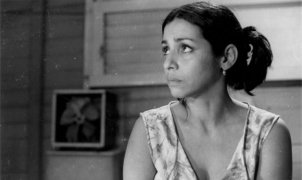 Valuable not only on a cinematographic levels was also the retrospective on Cuban cinema. In spite of the fact that Korea and Cuba at present have no diplomatic relations, JIFF has succeeded in introducing and screening thirteen Cuban films: certainly one of the first occasions to see Cuban cinema in South-East Asia, and a rare opportunity for the local public to access to the last forty-five years of Cuban cinema. (Film still on the right is from Portrait of Teresa (1979) by Pastor Vega Torres)
Valuable not only on a cinematographic levels was also the retrospective on Cuban cinema. In spite of the fact that Korea and Cuba at present have no diplomatic relations, JIFF has succeeded in introducing and screening thirteen Cuban films: certainly one of the first occasions to see Cuban cinema in South-East Asia, and a rare opportunity for the local public to access to the last forty-five years of Cuban cinema. (Film still on the right is from Portrait of Teresa (1979) by Pastor Vega Torres)
This author prefers to forget the opening film Possible Changes, the first feature by Korean director Min Byung-kook, while the prologue to the opening ceremony, the Ogamdo performance (a blend of traditional Korean music, jazz and rock) impressively described the spirit of Jeonju itself and of JIFF: an harmonic coexistence of tradition and modernity.
However, if on the one hand it cannot be denied that Jeonju festival needs further amelioration (especially in logistics), and that the date chosen for JIFF (overlapping the date of steadily growing in importance Udine Far East Film Festival, and too close to the Cannes Film Festival) has not encouraged the presence of specialized press and foreign guests, on the other hand enthusiastic and committed staff as well as numerous volunteers seem to confirm the choices taken by the JIFF organizing committee.
In as hectic and rapidly growing a continent as Asia is, it will certainly be difficult to become a prestigious as well as a "must-not-miss" annual appointment, but JIFF organizers are working on a festival that both audiences, festival programmers and industry people (especially foreign personnel) should better take into serious consideration.
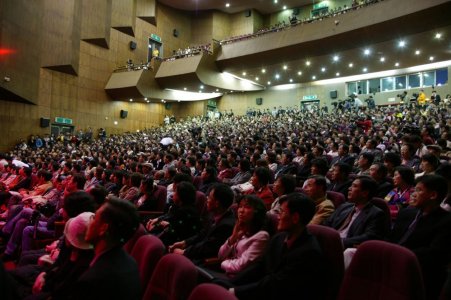
Opening ceremony, April 23, 2004
Tom Giammarco
Jeonju City located in the southwest of Korea is famous throughout the nation for its blending of traditional and modern culture. It is also widely acknowledged that Jeonju has the best cuisine in the country. However, Jeonju citizens have another reason to be proud of their city and that is the Jeonju International Film Festival (JIFF).
Debuting in 2000, this festival has grown to be one of the three largest film festivals in Korea. Rather than being a carbon copy of the Pusan or Puchon festivals, JIFF has developed a distinctive characteristic all its own. JIFF specializes as a showcase for digital and arthouse films which would otherwise not find a venue and it generally avoids more commercial movies that can readily be seen in theaters.
The 5th edition of JIFF was a ten-day festival which began this year on April 23 and ran through May 2. This placed it during one of the best times of year in Korea and the weather cooperated beautifully, with the exception of one rainy day. The time period also overlapped with two other traditional festivals of importance to Jeonju, the farmer's Pungman Festival and the Hansol Craft Festival, which added to the lively atmosphere in the city towards the end of the week.
This year, the festival used nine screens which each showed four films per day to accomodate 284 films from 33 countries, plus there was an outdoor venue at Cheonbuk University for nightly screenings of some popular Korean films. The slogan of the festival was 'Freedom, Independence, Communication' which was chosen to reflect the spirit of independent film makers.
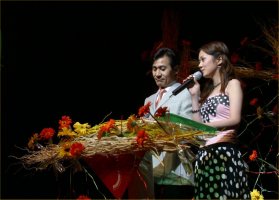 In keeping with the image of experimental and independent movies, the opening ceremonies were scaled back slightly from last year. However, that did not stop the opening night from being sold out within the first few hours after tickets went on sale. The master of ceremonies was actor Ahn Sung-ki who was assisted by singer/actress Jang Na-ra. In attendance were Im Kwon-taek, Yu Hyeon-mok, Mun Seong-geun, Kim Min-seon, Han Ga-in and other celebrities. Events got underway with a performance of Ogamdo which was a combination of Korean traditional music mixed with rock and jazz. The opening film was Min Byeong-guk's Possible Changes. Director Min later explained that this movie has been six years in the making from when he first won a local newspaper's award for best screenplay. It was a rather heavy film, filled with the ambiguities of life, the depression of the two leads as they approach middle-age and the struggles of one character to make even the smallest changes in his own world. However, it was well received and director Min and actors Jeong Chan and Kim Yu-seok fielded questions after the showing.
In keeping with the image of experimental and independent movies, the opening ceremonies were scaled back slightly from last year. However, that did not stop the opening night from being sold out within the first few hours after tickets went on sale. The master of ceremonies was actor Ahn Sung-ki who was assisted by singer/actress Jang Na-ra. In attendance were Im Kwon-taek, Yu Hyeon-mok, Mun Seong-geun, Kim Min-seon, Han Ga-in and other celebrities. Events got underway with a performance of Ogamdo which was a combination of Korean traditional music mixed with rock and jazz. The opening film was Min Byeong-guk's Possible Changes. Director Min later explained that this movie has been six years in the making from when he first won a local newspaper's award for best screenplay. It was a rather heavy film, filled with the ambiguities of life, the depression of the two leads as they approach middle-age and the struggles of one character to make even the smallest changes in his own world. However, it was well received and director Min and actors Jeong Chan and Kim Yu-seok fielded questions after the showing.
The festival was now underway and the program seemed to offer something for everyone. Some highlights include a section of Cuban Cinema which exhibited films rarely seen outside of that Caribbean nation. A number of Cuban directors were in attendance to answer questions including Fernando Perez and Maria Cabrera Castillo. Daniel Diaz Torres, who was arriving with his print of Drink Me, came a day late because of the new security procedures at Toronto forcing the cancellation of the screening on the 28th, but he arrived the next day and participated in the showing of his film and the question and answer session that followed.. A total of twelve Cuban films were shown in all, including Juan Carlos Cremata Malberti's Nada (2001), Humberto Padron's Family Video (2001) and Juan Carlos Tabio's House Swap (1984).
One extremely popular segment of the festival was the Masterclass Of Film-makers Forum which, this year, invited three world class cinematographers to hold lectures and explain a selection of their films. On April 26, Caroline Champetier answered questions and gave a lecture following the screening of H-Story (2001). Other works included La Sentinelle (1992) and Helas Pour Mi (1993). The following day, Korean cinematographer Jung Il-sung spoke about his works which is like listening to a history of Korean cinema. His debut film was in 1957, Jo Keung-ha's Farewell Sorrow, and he continues working up until today after overcoming what doctors thought was an incurable form of cancer. He claims not to have done much experimentation with camera work in his films but, watching his technique from decade to decade, one can see a definite sign of maturing over the years. Four films that he worked on were shown: Chunhyang (2000), Hwang Jin-i (1986), Mandala (1981) and Son Of Man (1980). Finally Brazilian cinematographer Walter Carvalho gave a presentation on the 28th. The three films representing his works were Love Movie (2003), Janela da Alma (2001) and Lavoura Arcaica (2001).
It should be of no surprise that Korean films were well represented at JIFF. There were sections entitled Korean Cinema: Collision and Continuity, another called Korean Animation and still another titled Korean Shorts: Critics' Week. These sections feature the work of many talented new film-makers, most just out of film school. They demonstrate a wide range of visions and techniques and are proof that the future of Korean films is strong. I look forward to seeing more works by directors Noh Dong-seok (My Generation), Kwon Mi-jeong (I'm In Big Trouble), Park Yong-jae (Why Not Community), Na Ji-in (Requiem), Kang Won-seok (A Fellow Traveller), Kwon Yong-suk (Vivace Again) and Yun Jun-hyeong (Mokdugi Video). On a personal note, I was very excited to see My Korean Cinema. In attendance of the screening was its director Kim Hong-jun whose last feature was in 1996. Mr Kim is the reason why I became interested in Korean movie history and classic films through his weekly EBS television program. My Korean Cinema is a work in progress. It currently consists of 5 episodes, most of them made up of clippings of older films edited together and narrative added. Director Kim mentioned in an early interview that it may become thirty or fifty episodes in length when he finishes but he does not know at this time how long it will become.
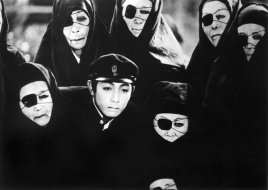 Another section of JIFF was the ATG Retropective. ATG stands for Art Theater Guild, an organization in Japan which was created in 1961 to foster and protect independent movies. Ten films were screened from this section including Pastoral: To Die In The Country (1974, Terayama Shuji -- pictured left) which was memorable for its bizarre imagery and Parade Of Roses (1969, Matsumoto Toshio), a film whose theme seemed to be decades before its time. Unfortunately, Muto Kiichi of Japan's New Cinema Workshop warned that Japan's art cinema has been experiencing severe problems do to a lack of interest among young movie-goers and since the 1990's independent films have not been able to recoup the expenses. A seminar hosted by Kim Seong-wook of the Seoul Art Cinema recognized a similar problem in Korea when they concluded that "Independent theaters and distribution networks are urgently needed for the screening and distribution of independent films."
Another section of JIFF was the ATG Retropective. ATG stands for Art Theater Guild, an organization in Japan which was created in 1961 to foster and protect independent movies. Ten films were screened from this section including Pastoral: To Die In The Country (1974, Terayama Shuji -- pictured left) which was memorable for its bizarre imagery and Parade Of Roses (1969, Matsumoto Toshio), a film whose theme seemed to be decades before its time. Unfortunately, Muto Kiichi of Japan's New Cinema Workshop warned that Japan's art cinema has been experiencing severe problems do to a lack of interest among young movie-goers and since the 1990's independent films have not been able to recoup the expenses. A seminar hosted by Kim Seong-wook of the Seoul Art Cinema recognized a similar problem in Korea when they concluded that "Independent theaters and distribution networks are urgently needed for the screening and distribution of independent films."
That conclusion tied in well with JIFF's closing film, a Spanish movie called November (2003) directed by Archero Manas which showed how the love of art theater can be swayed, and ultimately destoryed, by money and politics. Despite the serious message, the movie is also a light comedy and proved to be an excellent choice as the final film.
While JIFF is not really a competitive festival, there are two prizes awarded; the Woosuk Award for the best independent film and the Daring Digital Award for the best digital film. Lee Kwang-mo, director of Spring In My Hometown and CEO of the Korean Film Art Centre (Baekdu-daegan); Tereza Brdeckova, programmer of the Czech Republic's Febiofest; and Yukiko Shii, producer, bestowed the Woosuk Award on Silence Between Two Thoughts (2003) by Iranian director, Babak Payami who won a Silver Bear in Venice for his previous film, Secret Ballot. Highlighting sexual discrimination in Iran, it is the story of an executioner who is under orders by the village chief to marry a condemned female so she will no longer be a virgin and thus be prevented from entering heaven. Special mention was given to the Malaysian film, Min (2003) directed by Ho Yuhang. It is a very introspective film with long takes and longer silences of a young Chinese girl who was adopted by a Malyasian family but is now searching for her birth mother.
 The Daring Digital Award went to the Cuban documentary Suite Havana (2003, pictured right) directed by Fernando Perez. There is absolutely no dialogue in this film, nor are there narrations or interviews. Rather it is the stories and images of various, unusual people living in Havana. For example, there is a doctor who works part-time as a clown, a woman married to a drag queen, a construction worker who wants to be a ballet dancer and so on. The runner up which received special mention was a co-production from Bolivia and the USA entitled Sexual Dependency (2003). Directed by Rodrigo Bellott, this film has a unique, vertically split screen. Two cameras were placed at the filming site so that the same scene can be viewed from different perspectives.
The Daring Digital Award went to the Cuban documentary Suite Havana (2003, pictured right) directed by Fernando Perez. There is absolutely no dialogue in this film, nor are there narrations or interviews. Rather it is the stories and images of various, unusual people living in Havana. For example, there is a doctor who works part-time as a clown, a woman married to a drag queen, a construction worker who wants to be a ballet dancer and so on. The runner up which received special mention was a co-production from Bolivia and the USA entitled Sexual Dependency (2003). Directed by Rodrigo Bellott, this film has a unique, vertically split screen. Two cameras were placed at the filming site so that the same scene can be viewed from different perspectives.
Most people whom I spoke to had positive things to say about this year's festival. A common complaint, one that I have heard about other festivals as well, was the distance between venues. While most of the theaters are in a central location downtown, the Deokjin Art Theater and Cheonbuk University are on the other side of the city. Because of the relatively small size of Jeonju and with shuttle buses provided, this was not a huge problem but there are already plans to alleviate this situation for next year's festival. Yet another large cinema is being constructed downtown across the street from the new CGV that will be used by JIFF for its opening and closing films.
Even though attendance was slightly down from last year, which no doubt is because of the lack of commercial films with recognizable actors to draw people in, I found Jeonju's festival be more enjoyable and more organized than in past years. It is a event of growing importance, not only in Korea, but in the world of art films and it is a festival that has found its own niche in the hearts of Jeonju citizens and in Korean cinema.
(Photos and stills taken from JIFF's press service)